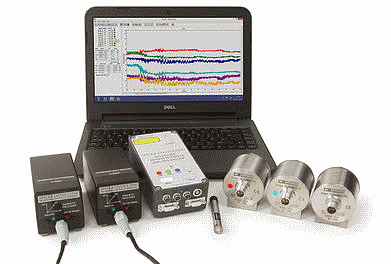The SC11 – from origin to the gold standard for site surveys
The importance of a suitable environment for the best electron microscope performance is well known. As technology has advanced over the years, microscopes have become more sensitive to interference, which can originate from all manner of causes, including vibrations and magnetic fields from nearby equipment, doors opening and closing, traffic, power cables, trains and lifts, as well as problems in the power supply, such as badly wired fluorescent lighting and ground loops.
This is why Spicer Consulting developed the SC11 Analysis System in 1996, purpose designed to perform site surveys, so that you know whether the environment is in spec for the instrument that you require.
Nowadays, the SC11 is the gold standard for screening environments where a new microscope might be installed, or for troubleshooting technical issues with an existing microscope by measuring and analysing any interference. In both scenarios, a site survey measures magnetic fields and floor vibrations in X, Y and Z directions, as well as acoustic levels, directly comparing these values with the environmental specifications of the equipment to be installed. Any problems can be identified from this analysis, and solutions proposed, such as the installation of a magnetic field cancelling system.
But how has the system adapted to the needs of our customers over the last 20 years?
The hardware
The SC11/Basic was developed in response to the need for a system that could measure the entire environment of a microscope. Although systems existed before this, they often included poor magnetic field sensors, and so the SC11/Basic was based on one of Spicer’s AC magnetic field sensors, but with added inputs for an accelerometer and a sound level meter. This system could make all the measurements required, but the user had to physically turn the vibration sensor in each direction to measure interference in the x, y and z axes!
From there, the system was upgraded so that more bandwidth of data could be collected, and higher frequencies could be evaluated on the spectrum analyser. Further rounds of upgrades, including a move to USB connection, led to the development of the SC11 sensor interface – SC11/SI – which allowed the SC11 to perform better measurements with more sensors. Then, a plug-in for DC sensors was added – so that AC and DC fields could be measured – along with three accelerometer inputs, allowing measurement in all three directions at the same time, instead of having to turn the sensor around. While the original only had only one magnetic field sensor input, later versions had two, enabling the simultaneous measurement of fields at two heights. This feature was important for TEM environments, which typically have tight field specifications over a length of more than two metres.
What about software?
The SC11 software has developed in parallel to changes in the hardware, and we are now on version 5.6.4. On first release, three separate programs were required – an oscilloscope, a chart recorder and a spectrum analyser – to make the necessary measurements, but the user needed a good understanding to be able to set them up correctly. To address this, we created the Wizard, which was able to guide the user through the process of measuring for different types of microscope. This was perfect for individuals who didn’t use the SC11 very often; they were able to simply turn the machine on, select the instrument they wanted to measure for, and the Wizard would bring up the correct program to make that specific measurement. We also created our own graph plotting software SC Plot, which allowed results to be viewed more easily than the original method using Excel macros. While the Wizard software was capable of running a single measurement, the next development, the Survey automation program, was capable of running a whole sequence of measurements to simplify the workflow for users even more.
Today’s SC11
Today, the SC11 is the most comprehensive purpose-designed surveying tool, standing the test of time over the last 20 years and used by leading electron microscope manufacturers worldwide. The SC11/Auto is now a completely automated system, capable of repeat surveying without human intervention. This enables long-term measurements, useful for expanding the surveying snapshot to study the environment at different times of the day.
So, if you are planning the installation of your next electron microscope or experiencing technical issues with your existing system, see how the SC11 could help by visiting https://www.spicerconsulting.com/which-sc11-you.
Spicer Consulting Limited, Eden Laboratory, Broadmead Road, Stewartby, Bedfordshire MK43 9ND, England
TEL:+44(0)1234 765773
Email: enq@spicerconsulting.com
© 2023 Spicer Consulting Limited.
All rights reserved. Privacy Notice.
Contact Us
We will get back to you as soon as possible.
Please try again later.


